Venturi meters and orifice meters are two common types of differential pressure flow meters that are used to measure the flow rate of fluids in pipes. Although both devices work by creating a constriction in the pipe, which causes a pressure drop that is proportional to the flow velocity, there are some differences between them in terms of design, accuracy, cost, and maintenance.

This article provides a comprehensive comparison between the venturi meter and the orifice meter, exploring their advantages, disadvantages, and applications in fluid flow measurement.
Venturi Meter vs. Orifice Meter: Differences and Similarities
Venturi meters and orifice meters are among the most widely used obstruction flowmeters. These flowmeters use the same principle of measuring the flow rate by restricting the flow, thereby creating a measurable pressure difference across the constriction. The pressure difference is normally measured using a differential pressure transducer or manometer.
According to Bernoulli’s principle, this pressure difference arises from the increase in velocity at the constriction point, and it can be related to the flow rate using the following equation:

Elevate Your Engineering With Excel
Advance in Excel with engineering-focused training that equips you with the skills to streamline projects and accelerate your career.
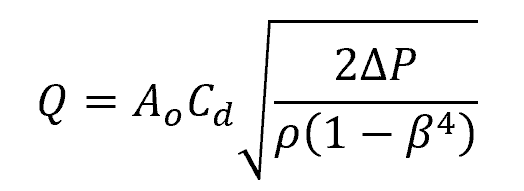
Where:
- Q = volumetric flow rate [m3/s]
- Ao = cross-sectional area of the constriction or hole [m2]
- Cd = discharge coefficient [unitless]
- ΔP = pressure difference across the constriction [Pa]
- ρ = density of the fluid [kg/m3]
- β = ratio of the hole diameter to pipe diameter [unitless]
The discharge coefficient is a correction factor that accounts for the losses due to frictional effects and the contraction of the fluid stream past the obstruction. Its value depends on both the beta ratio and the Reynolds number of the flow.
Although venturi meters and orifice meters work on the same principle of flow measurement, they are built differently.
Orifice Meter
An orifice meter consists of a flat plate with a hole or orifice in the center, placed perpendicular to the direction of fluid flow in the pipe. A diagram of a typical orifice meter is shown below:
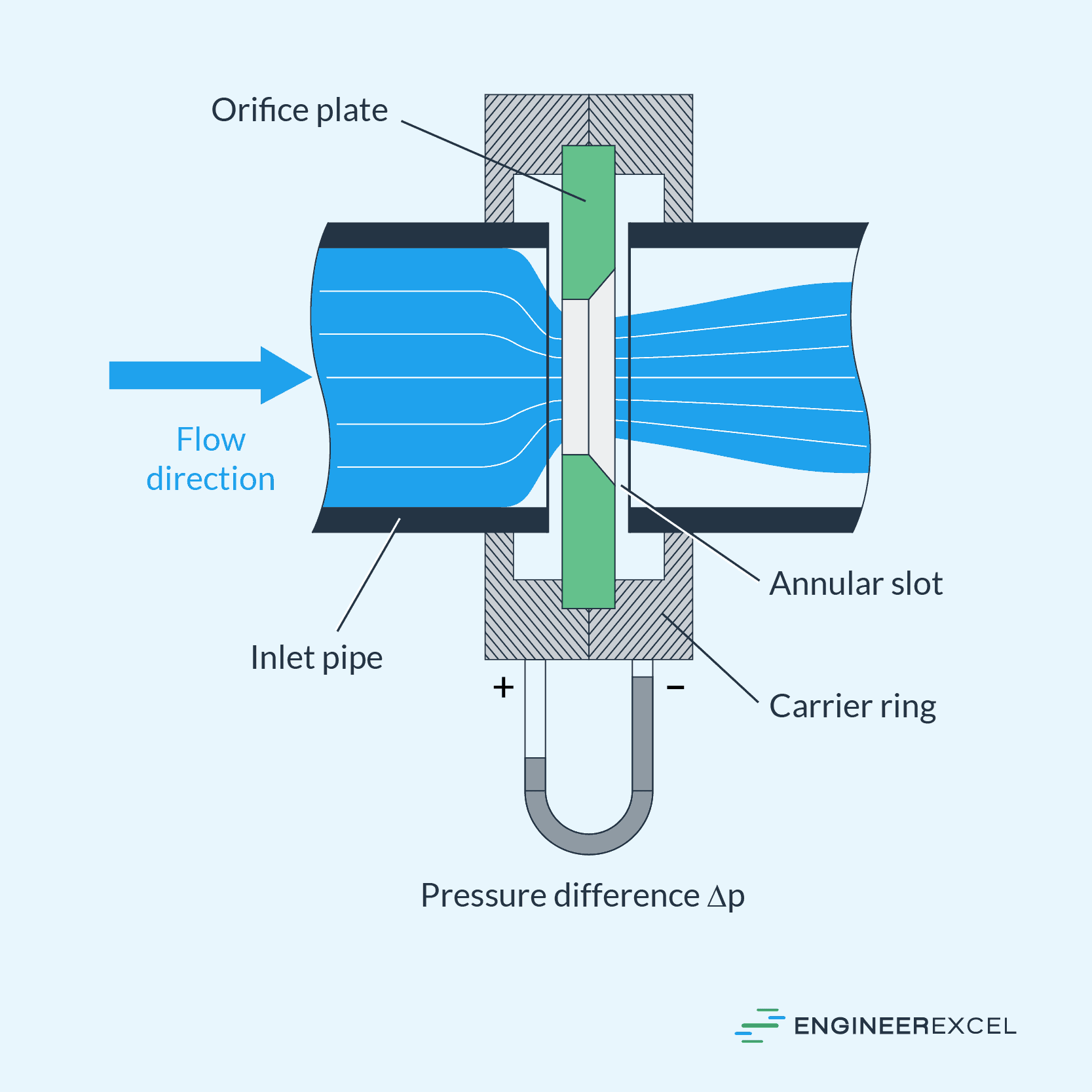
As shown in the diagram below, the orifice plate can have different bore configurations: concentric, eccentric, segmental, and quadrant edge. The choice of bore configuration depends on the application and flow conditions.
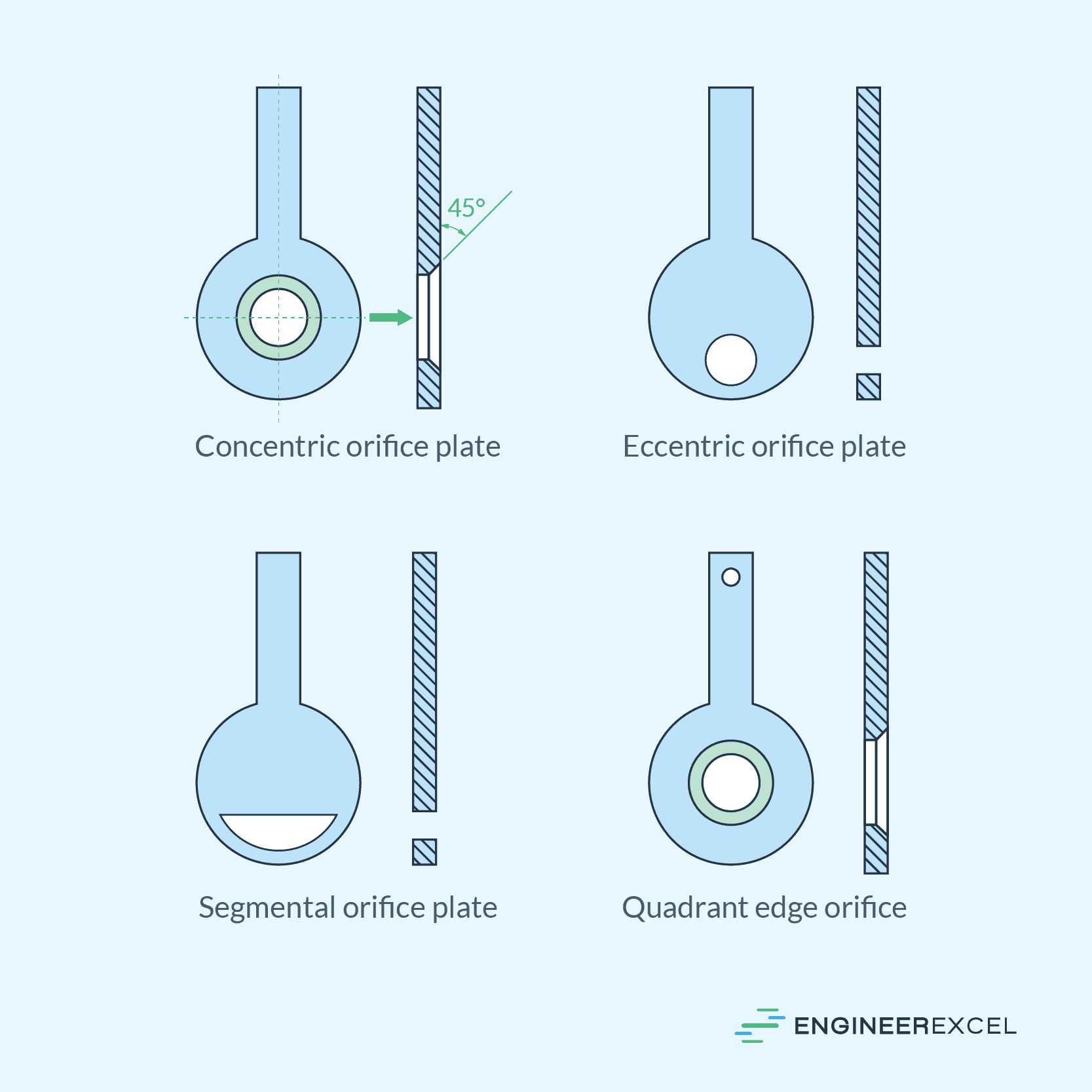
For example, a concentric orifice plate has a centrally located circular orifice with a sharp edge. This configuration ensures a symmetrical flow around the orifice, making it suitable for general flow applications.
A quadrant edge orifice plate also features a concentric opening. However, instead of a sharp edge, it has a rounded edge that is suitable for measuring viscous fluids. In addition, the rounded edge minimizes the erosive effects of suspended particles passing through the orifice, reducing wear and extending its lifespan.
Lastly, eccentric and segmental orifice plates have off-center openings located at the bottom of the plate. This configuration minimizes the risk of blockage due to impurities, making them suitable for measuring fluids that contain small amounts of suspended solids, slurries, or viscous materials.
Venturi Meter
Instead of a flat plate, a venturi meter consists of a converging section, a throat, and a diverging section, as shown in the diagram below.
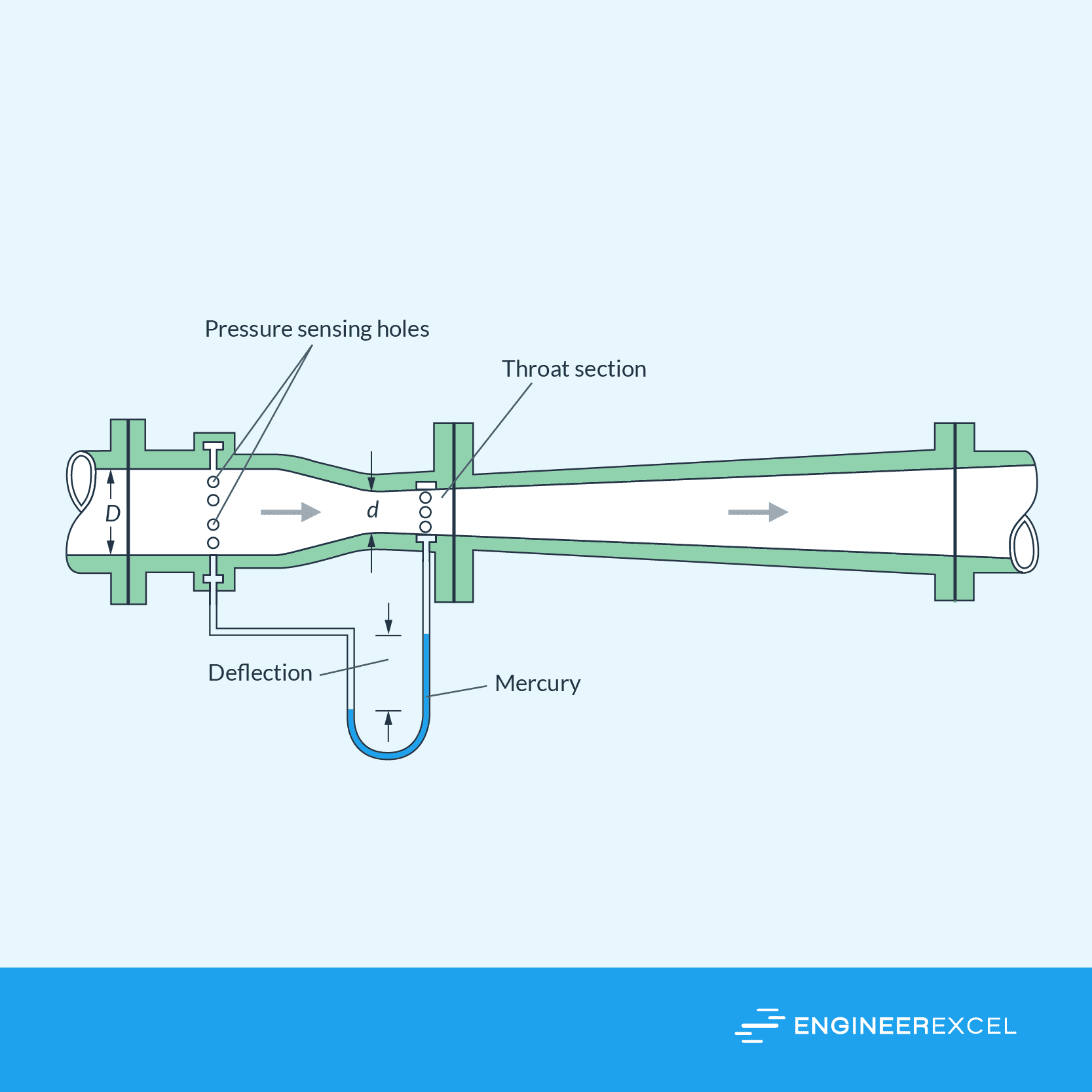
As fluid enters the converging section, it gradually gains velocity as it flows through the decreasing cross-sectional area. At the throat, it reaches its maximum velocity and minimum pressure. After passing through the throat, the pipe gradually expands again, allowing the pressure to recover as the velocity decreases.
The pressure difference used to calculate the flow rate is measured between the inlet and the throat of the venturi meter.
Venturi Meter vs. Orifice Meter: Advantages and Disadvantages
The choice between a venturi meter and an orifice meter often depends on the specific application and measurement requirements. This section compares the pros and cons of venturi meters and orifice meters in terms of construction, cost, maintenance, pressure loss, and accuracy.
Construction and Cost
The venturi meter has a more intricate design compared to the orifice meter. This makes it more expensive to fabricate and install.
On the other hand, the orifice meter is widely used due to its simplicity and cost-effectiveness. Since it is only composed of a flat plate, it generally consumes less space along the pipeline and requires fewer material resources.
Maintenance
Although the design of the venturi meter is more complex, it generally has fewer maintenance requirements, as it is less prone to wear and tear due to its streamlined structure. On the other hand, the orifice meter is more susceptible to wear and tear due to its sharp edges, which induce an abrupt change in fluid velocity across the flowmeter.
Pressure Loss
The venturi meter has a streamlined structure, composed of a gradually converging inlet section, a narrow throat, and a diverging outlet section. This design effectively reduces swirling, thus minimizing energy and pressure losses. This makes it suitable for applications where energy conservation is a priority.
On the other hand, the sudden change in the flow area in an orifice meter causes significant swirling, leading to significant pressure loss. As shown in the diagram below, right after passing the orifice plate, the pressure hits its lowest point. However, as the fluid travels down the pipe, it starts to recover some of this pressure loss.

The graph below shows a comparison of the pressure loss of orifice meters to that of venturi meters, relative to the beta ratio. In general, the higher the beta ratio, the lower the pressure loss.
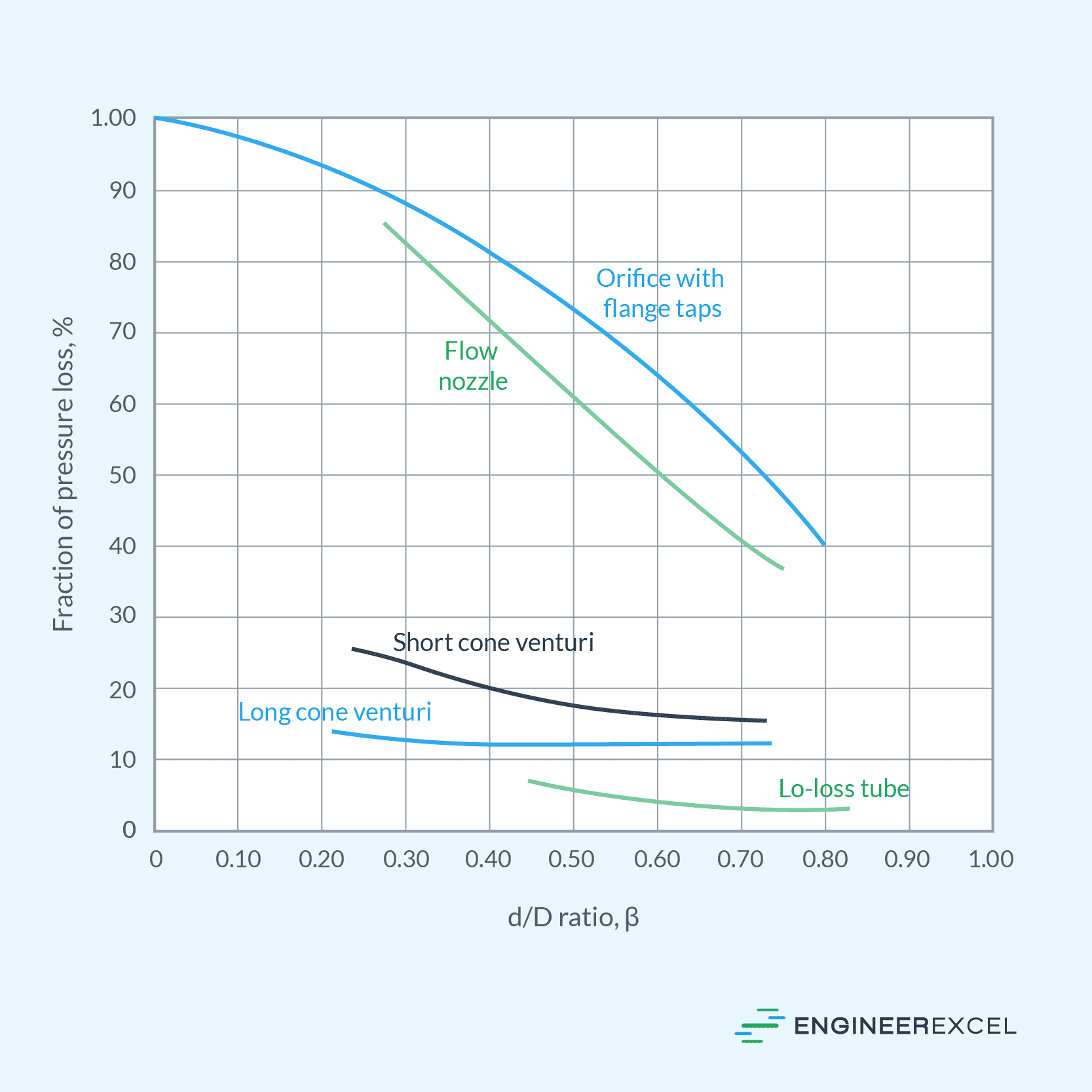
Accuracy and Discharge Coefficient
While Orifice meters provide acceptable accuracy for general applications, they may not be as precise as venturi meters, particularly at lower flow rates. When precision is crucial, such as in transfer of high-value fluids like crude oil or natural gas, venturi meters are often preferred.
In general, the accuracy of flowmeters is related to the discharge coefficient. The higher the discharge coefficient, the higher the accuracy.
For orifice meters, the following empirical formula can be used to approximate the discharge coefficient:

Where:
- Re = Reynolds number [unitless]
This equation is valid for beta ratios between 0.25 and 0.75, and Reynolds numbers between 104 and 107. For flows with high Reynolds numbers above 30,000, the discharge coefficient of orifice meters can be taken to be about 0.61.
For venturi meters, the discharge coefficients are very high, ranging between 0.95 and 0.99. The higher the Reynolds number, the higher the discharge coefficient.
However, precise values of the discharge coefficient depend on the particular design of the flowmeter. Hence, it is always recommended to consult manufacturer’s data when available.
Rangeability or Turndown Ratio
Turndown characterizes the range over which a flowmeter can accurately measure flow rate. It is defined as the ratio between the maximum and minimum flow rates that a flowmeter can measure within a specified accuracy.
In general, venturi meters have a higher turndown ratio than orifice meters. The typical turndown ratio for a venturi meter is 10:1, while for an orifice meter, it is 3:1.
However, while the venturi meter accommodates a wider range of flow rates compared to the orifice meter, its flow rate capacity is fixed upon installation and operation. On the other hand, with orifice meters, it is easy to replace orifice plates with varying hole diameters or configurations to adjust the flow rate capacity. Hence, orifice meters provide more operational flexibility
Venturi Meter vs Orifice Meter: Applications
Both the venturi meter and orifice meter can measure flow rates of continuous flows with a well-defined flow profile.

Orifice meters can be used in general and non-critical applications, such as water treatment plants, water distribution, and processing plants. They are chosen mainly for their cost-effectiveness and flexibility. However, when higher accuracy and lower pressure loss are required, the venturi meter is a better choice.
Venturi meters can measure flow rates of liquids, gases, vapors, slurries, and even high-viscosity fluids accurately. On the other hand, orifice meters are generally not suitable for highly viscous fluids as they can introduce significant errors due to high frictional losses.
Venturi meters are also able to measure low flow rates accurately, making them suitable for applications like laboratory experiments and chemical dosing systems. They can be installed horizontally, vertically, or at an angle. In contrast, the orifice meter requires a straight pipe installation to ensure that the fluid’s velocity flows perpendicular to the orifice plate.
